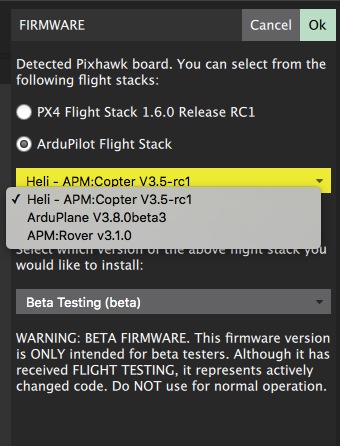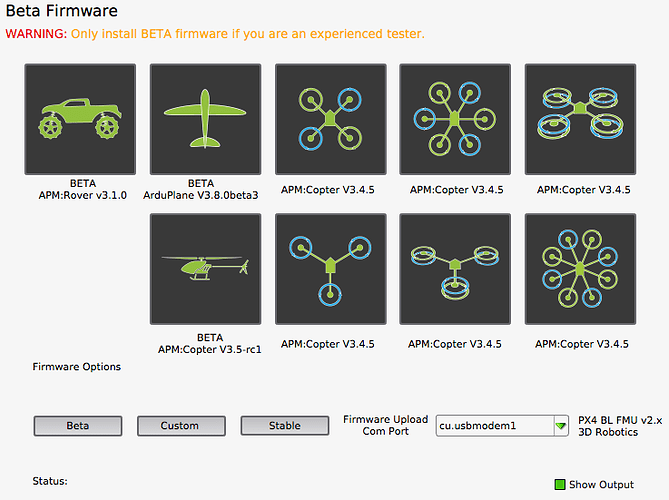The “Pixhawk mini” is supported as a build target, just in case someone buys one.
It doesn’t compare to ph2.1 - the mini is just a pixfalcon with some sensors updated. Having the buzzer on the pcb is convenient but not intelligent as it introduces vibrations to the IMU.
Strongly recommend ph2.1. Temperature stabilized and vibration isolated.
If you want a full size Pixhawk, then get a Pixhawk2.1. If you need a smaller version, go for a Pixracer.
I’m flying and driving only non-3DR APM’s (one in a TriPlane, the other in a Rover), and non-3DR Pixhawks (one in a TriPlane, the other in a fixed-wing), and don’t have any problems with those either. And I think they’re probably better quality hardware than what came from 3DR. The Pixhawk 2.1 is being built in Asia too, which is pretty much the electronics capital of the world. It’s just a matter of which one you want, and how much you want to pay for it. If you want cutting edge, go with the 'hawk 2.1. If you want tried and true, go with the Pixhawk, Pixracer, or APM. Even the APM, which 3DR tried to kill a couple years back, is still being turned out by the metric boatload by various Chinese manufacturers.
One of the original co-founders of 3DRobotics has started his own company (mRobotics), and seems to be manufacturing the original (3DR-like) Pixhawk again:
All out of stock. Need to find a real one.
I have not tried it yet but I just ordered a mini because it was actually a very good deal price wise.
3dr “claims” it has more better sensors in it - I guess we will see.
I would have gone with a 2.1, but they seem to be out of stock and I was not sure if the level of support was there yet.
As for “clones” (ok, unbranded units) I was very unsure of getting one, as has been mentioned it can be hit or miss - too bad there is no way to brand them and track issues.
An STM32 is an STM32 to be sure - the issue is the quality of the sensors. I have bought many unbranded devices on ebay and it is hit or miss.
I don’t view 3DR as being the Crown Jewel in hardware quality. They had problems too.
There’s none of this stuff that isn’t coming from Asia. I really don’t think it makes any difference what brand name is on it because the sensors are likely all built in the same place. The specs for the boards I been getting say:
Processor:
- 32 bit 2M flash memory STM32F427 Cortex M4, with hardware floating point processing unit
- Main frequency: 256K, 168MHZ RAM
- 32 bit STM32F103 backup co processor
Sensor:
- L3GD20 3 axis digital 16 bit gyroscope
- LSM303D 3 axis 14 bit accelerometer /magnetometer
- MPU6000 6 axis accelerometer / magnetometer
- MS5611 high precision barometer
I don’t know if all the Pixhawks from various vendors are the same or not. But the ones I been getting have yet to have a problem. And I have flown them, on average, 5-7 hours a week.
Thanks for you input Chris.
I certain agree that 3DR is not gods gift. I’ve noticed a 3dr cult, paying ridiculous amounts on ebay for 3dr pixes.
The fact that they had problems is a benefit - I am sure they do not want that to happen again.
The issue is not that it is made in Asia per se. The issue is that un-branded items may have unknown quality, it is not uncommon to get counterfeit parts. I can’t say I know that this is the case, but when manufactures get anonymity, it seems it is more likely to happen. I do know for a fact that counterfeiting does happen, and it is not uncommon to buy the parts and send them.
Please, it would be helpful to know where you get yours from, or any other guidance you may wish offer on tracking down well build pixhawks.
I’ve been getting my Pixhawks from Hobbypower, ordered thru Amazon. I hesitate to post a link as it might be viewed as “advertising” for a particular vendor. But you can look them up easy enough on Amazon. They have the board, M8N GPS units, telemetry radios, etc… It takes ~10 days to get it here from China, but everything has always been as advertised, and it all works.
As far as I know, the Pixhawk Mini is just the PixFalcon PX4 that was originally developed by HobbyKing and sold by various vendors like Bangood, etc… I’ve been flying a Pixhawk in a 700 and 600 heli, and the Pixhawk is kind of big with not a lot of mounting options. I’ve had some problems with mounting it underneath the heli with “noise” from the ESC and motor only 1cm away on my 600. The 700 is a nitro heli so don’t have that problem on that one. So I ordered a Pixhawk Mini from 3DR for it that I can mount on top of the tail rotor drive case. It comes with M8N GPS, etc., and looks to me like the spittin’ image of the PX4 sold by HobbyKing. It’s 38mm wide and just fits inside the main frame on top of the tail drive case, and other than the connectors is the same internally as the Pixhawk 2.4.8, I’m pretty sure. I figured I may as well get the “kit” from 3DR then I know all the connectors match. Although I did have to order a 6S power module for it separately, which is the same Crius 6S module I get with the Pixhawk when I order one from Hobbypower.
So I think 3DR is not making anything. They are just a reseller now.
@jcdonelson Have you looked at our store list? I doubt you can’t find one Pixhawk (or compatible) board in, at least, one of those.
It’s difficult to make an informed judgment on the Pixhawk Mini when 3DR has not (to my knowledge) released schematics.
The buzzer that is onboard may be an issue:
I think you are correct Chris the PixFalcon is identical right down the the included accessories excluding the 3dr BEC they ship.
They can be had on ebay for around 85.00.
It says on 3DR’s website that it was developed in cooperation with HobbyKing, or whatever. 3DR initially pushed it as being something new, but in reality it’s been around since the first Holybro/HobbyKing mini boards were built in like 2015. It’s possible 3DR is spec’ing higher-end sensors on the sensor board or something. But I kind of doubt it. I think it’s just a PixFalcon PX4 with different printing on the case. And they are actually very good boards in a smaller formfactor than the full-sized Pixhawk, and using JST connectors instead of DF13. The only bad part about the Pixfalcon/mini is that for like a helicopter you have to build a servo power rail because the signal out is just the signal and there’s a harness that plugs into the output port. It doesn’t have a built-in servo power rail like the full-sized Pixhawk, that accepts Futaba J connectors.
According to the introduction post, these are the improvements over Pixfalcon:
What’s improved over Pixhawk 1?
-
One third the size–dimensions reduced from 50 mm x 81.5 mm x15.5 mm to 38 mm x 43 mm x 12 mm. Smaller airframes can now operate autonomously without making sacrifices for the Pixhawk footprint.
-
Rev 3 STM32 processor allow for full utilization of 2MB flash memory. Pixhawk Mini operates at only 50% compute capacity, 40 percentage points lower than the original Pixhawk. There is significantly more overhead available to run custom code.
-
Improved sensors, including both primary and secondary IMU (MPU9250 and ICM20608, respectively), lead to much better vibration handling and increased reliability.
-
GPS module included–Neo M8N with quad-constellation support and upgraded HMC5983 compass.
-
Micro JST connectors replace DF-13. We can all breath a sigh of relief.
-
Integrated piezo speaker and safety switch
What’s improved over Pixfalcon?
-
Again, improved sensors, including both primary and secondary IMU (MPU9250 and ICM20608 respectively) for much better vibration handling and increased reliability.
-
Dedicated CAN port for UAVCAN applications.
-
Includes 8-channel servo output board for planes and other vehicles requiring powered PWM output.
-
Includes I2C breakout board for a total of 5 I2C connections.
I think it’s a very good board. As I mentioned, the only real problem (it’s not really a problem) is the powered servo rail is not integral with the Pixfalcon/mini like it is with the full-sized Pixhawk. For heli’s where there’s limited installation room, you may or may not be able to use the separate servo rail board. What I ended up doing was building a servo power rail with wiring instead of using the board for a heli installation. So I made a “spiderweb” harness that plugs into my aux JST connector from the BEC that powers the head and tail servos, and takes up less room and allows more wiring routing options than the rail board. The separate rail board would nice in a plane where you have more room in the fuselage though. For a multi where you likely only need a signal to the ESC’s the servo rail is not needed at all.
I do not know how the mini/Pixfalcon compares to the Pixhawk2. I do not know if there is a size advantage or not.
Does anyone know if the Pixhawk Mini even works with the Arducopter firmware for a quadcopter. I recently got one of these and it works well with the PX4 flightstack, but it constantly throws the error with the APM:Copter V3.4.5 firmware. If it is not currently supported, does anyone know if support is in the near future?
Thanks for any insights.
You need 3.5 for using Pixhawk Mini.
In both qGC and APM Flight Planner 2.0, V3.5 doesn’t seem to be an option for X frame. It is my understanding that quad frames are working on 3.5 but it only allows me to use helicopter. Please let me know if I’m just being dense.

You’ll need to report it in their issues list. Our firmware is published here: http://firmware.ardupilot.org/Copter/beta/PX4/ You want v2 for your Mini.
Thanks for all the answers. =) Skipped the 3DR Mini and went for Pixhawk 2.1 Pro (two of them should arrive any day now, second batch). One will be working with Here+ RTK GNSS the other with the standard Here.
Clone is a word I use on those really cheap controllers that dont even have QC or guarantees and costs a fourth of a more reliable manufacturer. When you almost dont find any information on a “clone” on the web, then its not interesting to me. But, maybe the word clone shouldnt be used if it isnt a copy of another product, maybe it is a product the manufacturer have been designing themselves, I dont know.
A friend of mine have received Pixhawk in a nice box from one webshop and also received a Pixhawk in a plastic bag from another webshop. Are both pure 3DR Pixhawks? They look identical and have those small cards with information.
And me and the same friend have some APM 2.6’s… some with 2.6 on the top and others with a sticker 2.6. I have also had a APM with different ArduPilot-text on it. They have different color on the PCB as well. I dont know which ones are real anymore.  The all have the ecaxtly same case/box but different inside.
The all have the ecaxtly same case/box but different inside.
If I buy a controller and I like it, I may want another identical one, but that may be impossible if it is sold out in a webshop.
